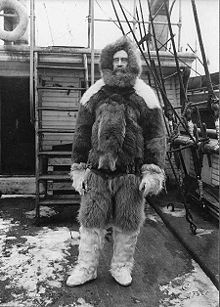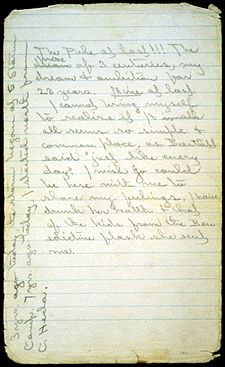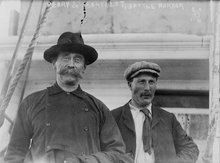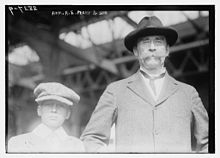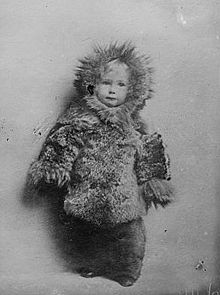- Robert Peary
-
Rear Admiral Robert Peary 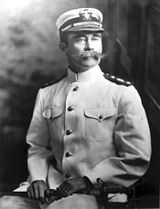
Peary in naval uniform circa 1910Born May 6, 1856
Cresson, PennsylvaniaDied February 20, 1920 (aged 63) Nationality American Known for Geographic North Pole Spouse Josephine Diebitsch Peary Children Marie Ahnighito Peary
Robert Edwin Peary, Jr.Robert Edwin Peary, Sr. (May 6, 1856 – February 20, 1920) was an American explorer who claimed to have been the first person, on April 6, 1909, to reach the geographic North Pole. Peary's claim was widely credited for most of the 20th century, though it was criticized even in its own day and is today widely doubted.
Contents
Life and career
Early years
Robert Edwin Peary was born in Cresson, Pennsylvania, in 1856. Peary graduated from Bowdoin College, Phi Beta Kappa,[1] in 1877.[2] His home in Fryeburg, Maine, still remains in pristine condition as an inn known as the Admiral Peary House.
Initial Arctic expeditions
Peary made several expeditions to the Arctic, exploring Greenland by dog sled in 1886 and 1891 and returning to the island three times in the 1890s, including the Peary Relief Expedition to Greenland of 1892. He twice attempted to cross northwest Greenland over the ice cap, discovering Navy Cliff. American artist F. W. Stokes joined some of these expeditions.
Unlike most previous explorers, Peary studied Inuit survival techniques, built igloos, and dressed in practical furs in the native fashion both for heat preservation and to dispense with the extra weight of tents and sleeping bags when on the march. Peary also relied on the Inuit as hunters and dog-drivers on his expeditions, and pioneered the use of the system (which he called the "Peary system") of using support teams and supply caches for Arctic travel. His wife, Josephine, accompanied him on several of his expeditions. During the course of his explorations, he had eight toes amputated.
Peary's fame
His 1898-1902 expedition was darkened by an unfounded attempt to put forth an 1899 visual discovery of "Jesup Land" west of Ellesmere, leading to his allegation that this was his sighting of Axel Heiberg land prior to its discovery by Norwegian explorer Otto Sverdrup's expedition, a Peary claim now universally rejected. However, the genuine achievements of this remarkable expedition were weightier. The gold medals of the American Geographical Society and Royal Geographical Society of London honored Peary's tenacity, his mapping of his considerable real discoveries, and his discovery in 1900 of Cape Jesup at the north tip of Greenland. Peary also achieved a farthest north for the western hemisphere in 1902 north of Canada's Ellesmere Island.
The 1905-1906 expedition
Peary's next expedition was supported by a $50,000 gift by George Crocker,[3] who was the youngest son of Charles Crocker. Peary then used the money for a new ship. Peary's new ship Roosevelt battled its way through the ice between Greenland and Ellesmere Island to an American hemisphere farthest north by ship. The 1906 "Peary System" dogsled drive for the pole across the rough sea ice of the Arctic Ocean started from the north tip of Ellesmere at 83° north latitude. The parties made well under 10 miles (16 km) a day until they became separated by a storm, so Peary was inadvertently without a companion sufficiently trained in navigation to verify his account from that point northward. With insufficient food, and with the negotiability of the ice between himself and land an uncertain factor, he made the best dash he could and barely escaped with his life off the melting ice. On April 20, he was no further north than 86°30' latitude[4] yet he claimed to have the next day achieved a Farthest North world record at 87°06' and returned to 86°30' without camping, an implied trip of at least 72 nautical miles (133 km) between sleeping, even assuming undetoured travel.
After returning to the Roosevelt in May, Peary in June began weeks of further agonizing travel by heading west along the shore of Ellesmere, discovering Cape Colgate, from the summit of which he claimed in his 1907 publications[5] he had seen a previously undiscovered far-north "Crocker Land" to the northwest on June 24 of 1906. Yet his diary for this time and place says "No land visible"[6] and Crocker Land was in 1914 found to be non-existent by Donald MacMillan and Fitzhugh Green. On December 15, 1906, the National Geographic Society, which was primarily known for publishing a popular magazine, certified Peary's 1905-6 expedition and Farthest with its highest honor, the Hubbard Gold Medal; no major professional geographical society followed suit.
The final 1908-1909 expedition
For his final assault on the pole, he and 23 men, including Ross Gilmore Marvin, set off from New York City aboard the Roosevelt under the command of Captain Robert Bartlett on July 6, 1908. They wintered near Cape Sheridan on Ellesmere Island and from Ellesmere departed for the pole on February 28-March 1, 1909. The last support party was turned back from "Bartlett Camp" on April 1, 1909, in latitude no greater than 87°45' north. (The figure commonly given, 87°47', is based upon Bartlett's slight miscomputation of the distance of a single Sumner line from the pole.) On the final stage of the journey towards the North Pole only five of Peary's men, Matthew Henson, Ootah, Egigingwah, Seegloo and Ooqueah, remained. On April 6, he established "Camp Jesup" allegedly within 5 miles (8.0 km) of the pole. In his diary for April 7, Peary wrote: "The Pole at last!!! The prize of three centuries, my dream and ambition for twenty-three years. Mine at last." Peary was unable to enjoy the fruits of his labors to the full extent when, upon returning to civilization, he learned that Dr. Frederick A. Cook, who had been a surgeon on an 1891-1892 Peary expedition, claimed to have reached the pole the year before.
Honors and legacy
Peary's lobbying[7] early headed off an intention among some congressmen to have his claim to the pole evaluated by explorers. As eventual congressionally recognized "attainer" of the pole (not "discoverer" in deference to 1908 North Pole claimant Frederick Cook's supporters) Peary was given a Rear Admiral's pension and the Thanks of Congress by a special act of March 30, 1911. In the same year, he retired to Eagle Island on the coast of Maine, in the town of Harpswell. (His home there is now a Maine State Historic Site.) Civil Engineer Peary received honors from numerous scientific societies of Europe and America for his Arctic explorations and discoveries. He died in Washington, D.C., February 20, 1920, and was buried in Arlington National Cemetery. Matthew Henson was reinterred nearby on April 6, 1988.
The Liberty ship SS Robert E. Peary, the destroyer USS Peary (DD-226) the cargo ship USNS Robert E. Peary (T-AKE-5), and Knox-class frigate USS Robert E. Peary (FF 1073) were named for him. The Peary-MacMillan Arctic Museum at Bowdoin College is named for Peary and fellow Arctic explorer Donald B. MacMillan. On May 28, 1986, the United States Postal Service issued a 22 cent postage stamp in honor of Peary and Henson;[8] they were previously honored in 1959.[9][10]
Peary was the author of several books, the most famous being Northward over the Great Ice (1898) and The North Pole (1910). The movie Glory & Honor by Kevin Hooks (1998) effectively dramatizes his hellish 1909 journey to the vicinity of the pole. Even explorer A. Greely, who came (after initial acceptance) to doubt Peary's reaching 90°, correctly notes that no Arctic expert questions that (unlike Cook) Peary courageously risked his life travelling hundreds of miles from land and that he reached regions adjacent to the pole.
In his book Ninety Degrees North, polar historian and author Fergus Fleming describes Peary as "undoubtedly the most driven, possibly the most successful and probably the most unpleasant man in the annals of polar exploration." He was also one of the most intelligent, bold, and able. His skills with the instruments and the mathematics of surveying ensured that all of his genuine exploring discoveries are placed beyond doubt by his records of celestial observations in connection with magnetic variation determination and finding longitude by application of spherical trigonometry via logarithms.
Awards
- American Geographical Society Cullum Geographical Medal (1896)
- American Geographical Society Charles P. Daly Medal (1902)[11]
- The Royal Geographical Society of London special great gold medal
- The National Geographic Society of Washington the special great gold medal
- The Philadelphia Geographical Society great gold medal
- The Chicago Geographical Society Helen Culver medal
- Bowdoin College bestowed the honorary degree of doctor of laws
- New York Chamber of Commerce honorary member.
- Pennsylvania Society Honorary member
- Imperial German Geographical Society Nachtigall gold medal
- Royal Italian Geographical Society King Humbert gold medal
- Imperial Austrian Geographical Society
- Hungarian Geographical Society gold medal
- Royal Belgian Geographical Society gold medal
- Royal Geographical Society of Antwerp gold medal
- Royal Scottish Geographical Society special trophy from the -a replica in silver of the ships used by Hudson, Baffin, and Davis.
- Edinburgh University bestowed an honorary degree of doctor of laws
- Manchester Geographical Society Honorary membership
- Royal Netherlands Geographical Society of Amsterdam Honorary membership[12]
- Grand Officer of the Legion of Honor, awarded 1913[13]
Inuit descendants
Some modern critics of Peary focus on his treatment of the Inuit, including Minik Wallace, a boy who, with five other Inuit, was brought to the United States from Greenland in 1897. Most of them died, and Wallace had considerable difficulty in returning to his home. Other criticisms involve Peary's theft of several enormous meteorites from the same Inuit band. These allegedly were the only local source of iron, and were sold by Peary for $50,000.
Peary and Henson both fathered children with Inuit women outside of marriage. (So did many other European explorers of the Arctic; for example, Robert J. Flaherty fathered a son during the filming of Nanook of the North.) This was brought up by Cook and his followers during Peary's lifetime and would have damaged his advancement if it had been widely believed. Peary appears to have started his relationship with his Inuit wife Aleqasina (Alakahsingwah) when she was about 14 years old.[14] Furthermore, Peary's main financial backer was New York philanthropist Morris Ketchum Jesup, a major force in the founding of Anthony Comstock's New York Society for the Suppression of Vice. Many of the explorers knew the facts, but had no wish to mention them publicly, in case this endangered their financial backing by scandal-shy geographical societies or their own Inuit relationships.
By the 1960s the truth was widely acknowledged, and Peary’s son Kali was eventually brought to the attention of the broader American public by S. Allen Counter, who met him on a North America expedition. The "discovery" of these children and their meeting with their American relatives were documented in a book and documentary titled North Pole Legacy: Black, White and Eskimo.
Controversy
Peary's claim to have reached the North Pole has long been subject to doubt.[15] Some polar historians believe that Peary honestly thought he had reached the pole. Others have suggested that he was guilty of deliberately exaggerating his accomplishments. In recent years, Peary's account has encountered renewed criticism and skepticism, as reviewed by Berton (2001) and Henderson (2005).
Lack of independent validation
Peary did not submit his evidence for review to neutral national or international parties or to other explorers. Peary's claim was certified by the National Geographic Society,[when?] a major sponsor of his expedition, a few weeks before Cook's Pole pretension was rejected by a Danish panel of explorers and navigational experts.[when?] The Society's chief,[citation needed] Gilbert Grosvenor, furthermore persuaded the National Academy of Sciences not to get involved. The Royal Geographical Society of London gave Peary its gold medal in 1910, despite internal council splits which only became known in the 1970s. Neither the American Geographical Society nor any of the geographical societies of semi-Arctic Scandinavia has recognized Peary's North Pole claim.
Criticisms
The party that accompanied Peary on the final stage of the journey included no one else who was trained in navigation and could independently confirm (or contradict) Peary's own navigational work, a point exacerbated by Peary's omission to produce records of observed data for steering, for the direction ("variation") of the compass, for his longitudinal position at any time, or for zeroing-in on the pole either latitudinally or transversely beyond Bartlett Camp.[16]
Inconsistent speeds
The last five marches when Peary was accompanied by a navigator (Capt. Bob Bartlett) averaged no better than 13 miles (21 km) march northing. But once the last support party turned back at "Camp Bartlett" from where Bartlett was ordered southward, at least 130 nautical miles (240 km) from the pole, Peary's claimed speeds immediately double for the five marches to Camp Jesup, and then quadrupled during the 2½ day return to Camp Bartlett—at which point his speed slowed drastically compared to that pace. Peary's account of a beeline journey to the pole and back — which would have assisted his claim of such speed — is contradicted by companion Henson's account of tortured detours to avoid "pressure ridges" (ice floes' rough edges, often a few meters high) and "leads" (of open water between those floes). The conflicting and unverified claims of Cook and Peary prompted Roald Amundsen to take extensive precautions in navigation during his Antarctic expedition so as to leave no room for doubt concerning his 1911 attainment of the South Pole, which (like Robert Scott's a few weeks later in 1912) was supported by the sextant, theodolite, and compass observations of several other navigators. See Polheim.
Inadequate documentation of return
Following the alleged victory moment, Peary stopped writing in his diary until return to Bartlett Camp,[citation needed]
Conversation with Henson terminated
After his alleged victory, Peary permanently stopped conversing with Henson, a companion on the expedition.[citation needed]
Supporting evidence
Further evidence supporting Peary's claims has been developed in recent decades.
Diary
The diary that Robert E. Peary kept on his 1909 polar expedition, largely ignored by historians because it was unavailable, was finally opened to the public in 1986. Historian Larry Schweikart examined it, finding that: the writing was consistent throughout (giving no evidence of post-expedition alteration), that there were consistent pemmican and other stains on all pages, and that all evidence was consistent with a conclusion that Peary's observations were made on the spot he claimed. Further, in a previous article, Schweikart had compared the reports and experiences of Japanese explorer Naomi Uemura, who reached the North Pole alone in 1978, to those of Peary and found they were entirely consistent.[17]
1989 National Geographic studies
In 1989, the National Geographic Society (which had been a major sponsor of Peary's expeditions) concluded, based on two-dimensional photogrammetric analysis of the shadows in photographs and review of ocean depth measures taken by Peary, that he was no more than 5 miles (8.0 km) away from the pole. But since Peary's original camera (a 1908 #4 Folding Pocket Kodak) has not survived, and such cameras were made with at least six different lenses from various manufacturers, the focal length of the lens—and hence the shadow analysis which is based upon it—must be considered uncertain at best. The National Geographic Society has never released Peary's photos for independent analysis, and scientific specialists have questioned the Society's conclusions.[18] The National Geographic Society commissioned The Foundation for the Promotion of the Art of Navigation to resolve the issue. The Navigation Foundation's full report from December 11, 1989 has been published and is available here. Gilbert M. Grosvenor (President of the National Geographic Society from 1980 to 1996) is quoted as saying, “I consider this the end of a historic controversy and the confirmation of due justice to a great explorer.”
Review of depth soundings
It has been claimed by supporters of Peary and Henson that the depth soundings they made on the outward journey match recent surveys and so confirm that they reached the pole.[19] However, only the first few of the Peary party's soundings, taken nearest the shore, actually touched bottom; thus their usefulness is extremely limited, showing merely that he was above deep water.[20]
Recreation of expedition in 2005
British explorer Tom Avery and four companions recreated the outward portion of Peary's journey in 2005 with replica wooden sleds and Canadian Eskimo Dog teams, always ensuring that their sled weights mirrored Peary's sleds almost pound for pound throughout their journey. They reached the North Pole in 36 days, 22 hours – nearly five hours faster than Peary.[21] Avery writes on his web site that
"The admiration and respect which I hold for Robert Peary, Matthew Henson and the four Inuit men who ventured North in 1909, has grown enormously since we set out from Cape Columbia. Having now seen for myself how he travelled across the pack ice, I am more convinced than ever that Peary did indeed discover the North Pole."[22][dead link]
After reaching the Pole, Avery and his team were airlifted off the ice rather than returning by dogsled.
Analysis of the actual speeds made by Avery do more to cast doubt on Peary's claim than to confirm it. While Peary claimed 130 nautical miles (240 km) made good in his last five marches, horrific ice conditions meant that Avery managed only 71 in his last five marches. Indeed, Avery never exceeded 90 nautical miles (170 km) made good in any five-day stretch, although he was losing over 7 miles (11 km) a day at this time to the southerly drift of the ice.[23][dead link] Avery managed to match Peary's overall 37-day total in part because Peary was held up by open water for five days at the Big Lead. But Peary had his own advantages in that his team consisted of 133 dogs and 25 men, meaning he was able to keep his "polar party" fresh for the sprint to the Pole. Peary's team was also far more experienced in the ancient art of dog sledging.
Other media
Peary's exploits and life were portrayed in the 1998 TV movie Glory & Honor. Henry Czerny played Robert Peary. His associate Matthew Henson was played by Delroy Lindo. The film won a Primetime Emmy and a Golden Satellite Award for Lindo's performance as Henson.[24]
Notes
- ^ Who Belongs To Phi Beta Kappa, Phi Beta Kappa website, accessed Oct 4, 2009
- ^ "What They Packed". bowdoin.edu. http://www.bowdoin.edu/news/archives/1bowdoincampus/005262.shtml. Retrieved 2008-11-28.
- ^ "Peary Gets $50,000; M.K. Jesup Gives $25,000". New York Times: p. 7. 1905-07-13.
- ^ For obvious reasons, this latitude was never published by Peary. It is in a typescript of his April, 1906 diary, discovered by Sir Wally Herbert (Herbert, 1989). The typescript suddenly stops there, one day before the April 21 purported Farthest, and the original of the April 1906 record is the only missing diary of Peary's exploration career (Rawlins, Contributions).
- ^ E. g., R. Peary, Nearest the Pole, 1907, pages 202, 207, and 280
- ^ Rawlins, Contributions
- ^ See Congressman de Alva Alexander in Rawlins, 1973.
- ^ Scott catalog # 2223.
- ^ Scott catalog # 1128.
- ^ "Veterans and the Military on Stamps", pp. 5, 30, found at USPS website. Retrieved September 25, 2008.
- ^ "American Geographical Society Honorary Fellowships". amergeog.org. http://www.amergeog.org/honorslist.pdf. Retrieved 2009-03-02.
- ^ "Recognition of Robert E. Peary the Arctic explorer" (PDF). January 21, 1911. http://docs.lib.noaa.gov/rescue/IPY/IPY_017_pdf/G635p4b381911.pdf. Retrieved 2008-08-21
- ^ Appleton's cyclopædia of American biography, Volume 8 edited by James Grant Wilson, John Fiske, 1918, pg. 527
- ^ Herbert, Wally (1989). The Noose of Laurels. pp. 206–207
- ^ New York Times, "A Correction", August 23, 1988
- ^ Herbert, 1989; Rawlins, Contributions
- ^ Larry Schweikart, "Polar Revisionism and the Peary Claim: The Diary of Robert E. Peary," The Historian, XLVIII, May 1986.
- ^ For example, "Washington Post", December 12, 1989; "Scientific American", March and June, 1990
- ^ "Proof Henson & Peary reached Pole." Matthew A Henson website. Retrieved 11 August 2007.
- ^ Peary's expedition possessed 4000 fathoms of sounding line but he took only 2000 with him over an ocean already established as being deeper in many regions. See, e. g., D. Rawlins, U. S. Naval Institute Proceedings, June, 1970, page 38, and Polar Notes (Dartmouth College), volume 10, October, 1970, page 38.
- ^ Rawlins, Zero
- ^ Tom Avery website, retrieved May 2007
- ^ Avery's Route Barclay's Capital Ultimate North. Retrieved 10 March 2008.
- ^ Awards for "Glory & Honor" at The Internet Movie Database
References
- Berton, Pierre (2001). The Arctic Grail. Anchor Canada (originally published 1988). ISBN 0-385-65845-1. OCLC 46661513.
- Bryce, Robert M. (February 1997). Cook & Peary: the polar controversy, resolved. Mechanicsburg, PA: Stackpole Books. ISBN [[Special:BookSources/0-689-12034-6 LCCN 96-38215 LCC G635.C66 H86 1997|0-689-12034-6 LCCN 96-38215 LCC G635.C66 H86 1997]].
- Coe, Brian (1988, Rev. 2003). Kodak Cameras: The First Hundred Years. East Sussex: Hove Foto Books. ISBN 1874707375.
- Davies, Thomas D. (2010). Robert Peary at the North Pole. Starpath Publications, Seattle, WA (originally The Foundation For the Promotion of the Art of Navigation) http://starpath.com/catalog/books/1988.htm.
- Engstfeld, Axel - Minik The Lost Eskimo (PBS: The American Experience series, 2008) http://www.pbs.org/wgbh/amex/minik/
- Fleming, Fergus (September 27, 2001). Ninety degrees north: the quest for the North Pole. London: Granta Books. ISBN [[Special:BookSources/1-86207-449-6 LCCN 2004-426384 LCC G620.F54 2001|1-86207-449-6 LCCN 2004-426384 LCC G620.F54 2001]].
- Henderson, Bruce (2005). True North: Peary, Cook, and the Race to the Pole. W. W. Norton and Company. ISBN 0393327388. OCLC 63397177.
- Herbert, Wally (July 1989). The noose of laurels: Robert E. Peary and the race to the North Pole. New York, NY: Atheneum. ISBN [[Special:BookSources/0-689-12034-6 LCCN 89-90 LCC G635.P4 H4 1989|0-689-12034-6 LCCN 89-90 LCC G635.P4 H4 1989]].
- Rawlins, Dennis (1973). Peary at the North Pole: fact or fiction?. Washington: Robert B. Luce. ISBN [[Special:BookSources/0-88331-042-2 LCCN 72-097708 LCC G635.P4 R38|0-88331-042-2 LCCN 72-097708 LCC G635.P4 R38]].
- Robinson, Michael (2006). The Coldest Crucible: Arctic Exploration and American Culture. Chicago: University of Chicago Press. ISBN 978-0226721842.
- Schweikart, Larry - ""Polar Revisionism and the Peary Claim: The Diary of Robert E. Peary," The Historian, XLVIII, May 1986, pp. 341–58.
External links
- This article includes text from the public domain Dictionary of American Naval Fighting Ships.
- NY Times, April 6, 1909, Peary Discovers the North Pole After Eight Trials in 23 Years
- NY Times, September 7, 2009, A Clash of Polar Frauds and Those Who Believe
- Works by Robert E. Peary at Project Gutenberg
- Audiobook "The North Pole"
- Peary at Findagrave
Categories:- 1856 births
- 1920 deaths
- American explorers
- Bowdoin College alumni
- Burials at Arlington National Cemetery
- Discovery and invention controversies
- Explorers of the Arctic
- Grand Officiers of the Légion d'honneur
- People from Oxford County, Maine
- People from Pittsburgh, Pennsylvania
- United States Navy admirals
- Recipients of the Cullum Geographical Medal
Wikimedia Foundation. 2010.

